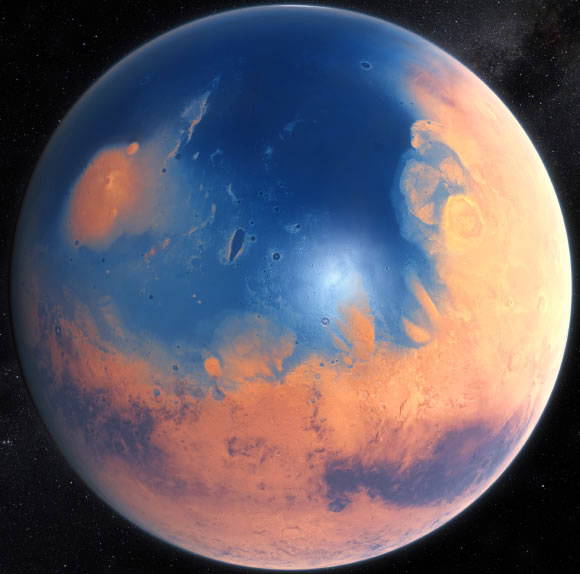Mars has life for 3.7 billion years, a terrifying species to Earth people
Researchers have analyzed the subsurface of Mars and found evidence of the presence of strange ancient creatures.
According to Sci-News , the research team led by Dr. Boris Sauterey from the Department of Ecology and Evolutionary Biology at the University of Arizona - USA and the Ecole Normale Supérieure Institute of Biology at the University of Sciences and Letters in Paris - France proved that that Mars had life 3.7 billion years ago.

Early green Mars once had life but destroyed itself - (Photo: NASA).
Martian creatures do not roam the planet's surface like we do, but reside in the layer just below the surface.
" Brine-saturated porous regolith would create a physical space shielded from ultraviolet and cosmic radiation, while also providing solvent, while subterranean temperature, density diffusion and The deterioration of the atmosphere here may have nurtured a type of microorganism that "eats" hydrogen and carbon dioxide to create energy, emitting methane gas" - Dr. Sauterey explained.
On Earth, the process of creating supernutrients from materials far removed from the food sources of today's living organisms has been demonstrated, but this is the first time it has been carefully examined for Martian conditions. .
Such a hydrogen-eating, methane-emitting life form was once thought to be Earth's earliest form of life, although it would be toxic to today's Earth creatures, including us, by emitting too much methane.
Modeling the interaction between this type of ancient life and the Martian environment, they found that this scenario would need one additional factor to occur: the surface was not completely covered by ice and had could create biomass similar to Earth's early oceans . Previous studies, including research from NASA, have determined that Mars was very likely to have been like that.
Hellas Planitia, Isidis Planitia and Jezero Crater may be the most suitable lands for that form of life, and are also where spacecraft should aim if they want to excavate fossils of ancient creatures.
The ancient biomass of Mars and Earth 3.7 billion years ago may have reached similar levels. However, this ancient ecosystem, when interacting with Martian conditions, would cool the globe to minus 223 degrees Celsius and inhibit the growth of more advanced organisms.
That could be the end of other potential life forms, causing it to become the dead planet it is today.
The research was just published in the scientific journal Nature Astronomy.
- Aliens may have been on Mars 3.8 billion years ago
- People will become pregnant, give birth and create a new human species on Mars?
- Life on Earth may have started over 4 billion years ago
- 4.5 billion year old meteorite revealed life on Mars
- Life on Earth will be destroyed after 3 billion years
- Evidence of 4 billion years of life on Earth is discovered
- Found life on Mars from microbial fossils
- Search for life on Mars
- Mars has water 3 billion years ago
- 'Move' up ... Mars, how much will it cost you?
- The landing of meteors 3.9 billion years ago has promoted life on earth
- Life began on Earth 3 billion years ago
 Announced 3 houses on the Moon and Mars
Announced 3 houses on the Moon and Mars Science proves: Mars also knows 'deflated'
Science proves: Mars also knows 'deflated' Elon Musk announced the price for a Mars trip was 11.6 billion VND, free of charge
Elon Musk announced the price for a Mars trip was 11.6 billion VND, free of charge NASA discovered strange 'gate' on Mars, is the hiding place found?
NASA discovered strange 'gate' on Mars, is the hiding place found?